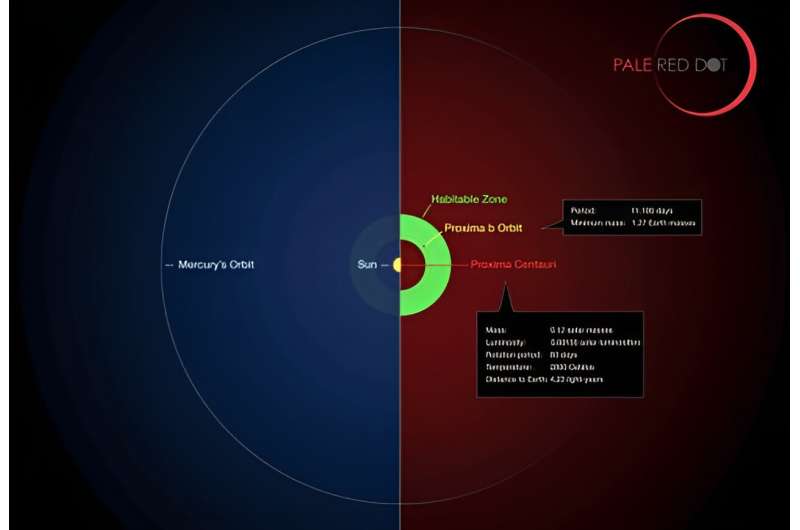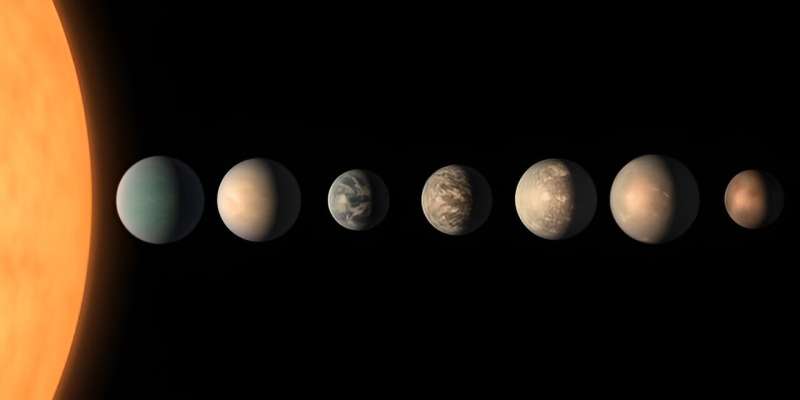This article has been reviewed according to Science X's editorial process and policies. Editors have highlighted the following attributes while ensuring the content's credibility:
fact-checked
peer-reviewed publication
trusted source
proofread
The ultraviolet habitable zone may set a time limit on the formation of life

The field of extrasolar planet studies has grown exponentially in the past 20 years. Thanks to missions like Kepler, the Transiting Exoplanet Survey Satellite (TESS), and other dedicated observatories, astronomers have confirmed 5,690 exoplanets in 4,243 star systems.
With so many planets and systems available for study, scientists have been forced to reconsider many previously held notions about planet formation and evolution and what conditions are necessary for life. In the latter case, scientists have been rethinking the concept of the Circumsolar Habitable Zone (CHZ).
By definition, a CHZ is the region around a star where an orbiting planet would be warm enough to maintain liquid water on its surface. As stars evolve with time, their radiance and heat will increase or decrease depending on their mass, altering the boundaries of the CHZ.
In a recent study, a team of astronomers from the Italian National Institute of Astrophysics (INAF) considered how the evolution of stars affects their ultraviolet emissions. Since UV light seems important for the emergence of life as we know it, they considered how the evolution of a star's Ultraviolet Habitable Zone (UHZ) and its CHZ could be intertwined.
The research team was led by Riccardo Spinelli, an INAF researcher from the Palermo Astronomical Observatory. He was joined by astronomers from the National Institute of Nuclear Physics (INFN), the University of Insubria, and the Astronomical Observatory of Brera.
Their paper, "The time evolution of the ultraviolet habitable zone," was recently published in the Monthly Notices of the Royal Astronomical Society: Letters.
As Spinelli told Universe Today via email, the UHZ is the annular region around a star where a planet receives enough UV radiation to trigger the formation of RNA precursors but not so much that it destroys biomolecules. "This zone primarily depends on the star's UV luminosity, which decreases over time," he said. "As a result, the UV habitable zone is farther from the star during the early stages of the star's evolution and gradually moves closer to the star as time progresses."
As astronomers have known for some time, CHZs are also subject to evolution, due to changes in the star's luminosity and heat output, which increase or decrease over time depending on the mass of the star. Addressing the interaction of these two habitable zones could shed light on which exoplanets are most likely to be "potentially habitable" for life as we know it.
As Spinelli explained, "We still do not know precisely how life originated on Earth, but we have some clues suggesting that ultraviolet (UV) radiation may have played a crucial role. Experimental studies, such as the one conducted by Paul Rimmer and John Sutherland in 2018, provide significant insights. In their experiment, Rimmer and Sutherland exposed hydrogen cyanide and hydrogen sulfite ions in water to UV light and discovered that this exposure efficiently triggered the formation of RNA precursors.
"Without UV light, the same mixture resulted in an inert compound that could not form the building blocks of life. Furthermore, RNA demonstrates a resistance to damage from UV radiation, indicating that it likely formed in a UV-rich environment. Indeed, UV radiation was one of the most abundant sources of chemical-free energy on the surface of the early Earth, suggesting it might have played a crucial role in the emergence of life."
For their purposes, Spinelli and his colleagues sought to determine if (and for how long) the CHZ and the UVZ would overlap—thus facilitating the emergence of life. To this end, the team analyzed data from NASA's Swift Ultraviolet/Optical Telescope (UVOT) to measure the current UV luminosity of stars with exoplanets that reside in the "classical" HZ.
They then consulted data from NASA's Galaxy Evolution Explorer (GALEX), an orbiting space telescope that has been observing galaxies up to 10 billion years away in the UV wavelength.

From GALEX, they incorporated how moving groups of young stars evolve in terms of their near-UV luminosity. "To estimate the evolution in time of the ultraviolet habitable zone, we used the results obtained by Richey-Yowell et al. 2023," said Spinelli. "In this work, the authors derived an average UV luminosity evolution for each type of star. In our work, we reconstructed the evolution of the UV brightness of stars hosting planets in the classical habitable zone by combining the average evolution derived by Richey-Yowell et al. 2023 and the measurements carried out with the Swift Telescope."
From this, they determined there is an overlap between the evolution of CHZs and UHZs. These results were especially significant for M-type (red dwarf) stars, where many rocky planets have been found orbiting within their CHZs. Previous research, which includes a 2023 paper by Spinelli and many of the same colleagues, has suggested that M-dwarf stars are not currently receiving near-UV radiation to support the prebiotic chemistry necessary for the emergence of life. However, their conclusions in this latest paper contradicted their previous findings.
Said Spinelli: "We assert that, when examining the evolution of NUV luminosity in M-dwarfs, most of these cool stars are indeed capable of emitting an appropriate amount of NUV photons during the first 1–2 billion yr of their lifetimes to trigger the formation of important building blocks of life.
"Our results suggest that the conditions for the onset of life (according to the specific prebiotic pathway we consider) may be or may have been common in the galaxy. Indeed, in this work, we demonstrated that an intersection between the classical habitable zone and the ultraviolet habitable zone could exist (or could have existed) around all stars of our sample at different stages of their life, with the exceptions of the coolest M-dwarfs (temperature less than 2,800 K, notably Trappist-1 and Teegarden's star)."
While they may be a bit of a letdown for those hoping to find life on some of TRAPPIST-1s seven rocky planets, it bodes well for other M-type stars hosting rocky planets in their HZs. This includes the closest exoplanet to the solar system (Proxima b), Ross 128 b, Luyten b, Gliese 667 Cc, and Gliese 180 b, all of which are within 40 light-years of Earth.
These findings could have significant implications for exoplanet and astrobiology studies, which have been transitioning from discovery to characterization in recent years.
These fields will benefit from next-generation telescopes like Webb, the Nancy Grace Roman Space Telescope, and ground-based observatories that will enable Direct Imaging studies of exoplanets.
More information: R Spinelli et al, The time evolution of the ultraviolet habitable zone, Monthly Notices of the Royal Astronomical Society: Letters (2024). DOI: 10.1093/mnrasl/slae064
Journal information: Monthly Notices of the Royal Astronomical Society Letters
Provided by Universe Today




















